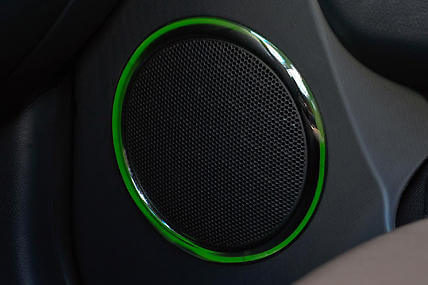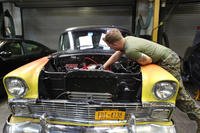Speakers are the final components in the signal chain in a car audio system. They play a very crucial role in the ultimate sound of the system. You can use the very best components in a car audio system, but if they're hooked up to lousy speakers, you get lousy sound. Conversely, you can have average components leading up to the speakers, but if you have great speakers, you get above-average sound.
Discovering how Speakers Speak
Speakers are supplied with juice from an amplifier via two wires or leads. One sends a positively charged current to the speaker, whereas the other returns a negative current to complete the circuit. The speaker moves back and forth in response to the electrical impulses that alternate from positive and negative voltages supplied by the amplifier. This alternating current supplied by the amplifier causes the speaker to create varying degrees of air pressure and reproduce various frequencies. When all of the speakers in a system do this, the result is music to your ears.
Different Type of Speakers
In a perfect world, one speaker could accurately reproduce the entire audible frequency spectrum from 20 to 22,000 Hz, without distortion. While we're in fantasyland, this ideal speaker would also be cheap and wouldn't require lots of power. Of course, we don't live in a perfect world and we don't have perfect speakers.
These different types of speakers include:
- Subwoofers that reproduce the lowest bass frequencies, roughly from as low as 30 Hz up to about 120 Hz. They typically have large cones that push large volumes of air, and they also require more power to do this. Subwoofers range in size from 8 to 18 inches.
- Midranges, also sometimes called woofers, reproduce midrange frequencies, roughly from 120 Hz to about 4,000 to 5,000 Hz. Because midranges are asked to handle a pretty wide range of frequencies, some systems also include midbass drivers to handle the lower end of the range. Midranges don't require as much power as subwoofers, and they range in size from around 3.5 to 8 inches.
- Tweeters reproduce the high end of the frequency range, usually from around 4,000 or 5,000 up to 22,000 Hz. They are typically about 1 inch in diameter or smaller and require much less power than midranges and subwoofers. The output of tweeters is also very directional, meaning that they aim their sound more than subwoofers and midranges do.
Although midranges and tweeters are sometimes sold separately, more often you'll find them grouped together. Subwoofers are sold separately.
Crossover Artists
Because you need to use speakers that are specialized at producing certain frequency ranges, you also need a way to make sure each speaker gets the frequencies it reproduces best. This is the job of crossovers or filters: devices that block certain frequencies that would not only be inappropriate for the speaker to reproduce but may potentially harm it.
Passive or Active
Crossovers come in two varieties - passive and active - but they basically do the same thing, and passive and active crossovers are often used in conjunction with one another. One major difference is active or electronic crossovers require electrical power, whereas passive crossovers don't.
Another big difference is that active crossovers filter the audio signal or before it's amplified. Therefore, electronic crossovers come before an amplifier in the signal chain, and many times an electronic crossover is built into an amp.
Passive crossovers, on the other hand, come after the amplifier in the signal chain and before the speaker. Passive crossovers almost always come with speakers that include more than one driver, such as coaxials or components. With a coaxial speaker, the passive crossover is usually a small and simple component called a capacitor that filters out the lows going to the tweeter.
Component speakers or separates usually have outboard or stand-alone crossover networks that contain capacitors to filter out the lows going to the tweeters as well as inductors to filter out the highs going to the midranges. Some also have settings that allow you to adjust the crossover point and crossover slopes.
In more sophisticated car audio systems, a separate electronic crossover or an amplifier's built-in crossover may divide the full range signal, containing the full frequency range, coming from the head unit. Then a component speaker set's passive crossovers further divide the signal between the midranges and tweeters in the system.
Crossover Type
Crossovers come in three basic configurations:
- Low-pass crossovers filter out all but low frequencies for subwoofers.
- High-pass crossovers filter out all but high frequencies for tweeters.
- Bandpass crossovers filter out all but a predetermined band of frequencies, usually in the midrange area.
Electronic crossovers can include all three types of crossovers, whereas passive crossovers usually just include a low-pass and/or high-pass section.
Speaker Specs
As with head units and amplifiers, you should be aware of a number of specifications that manufacturers give that allow you to compare various speakers when you're shopping.
Frequency Response
Frequency response is a measure of the frequency range that a speaker can accurately reproduce. For a 6.5-inch component speaker set, a frequency response spec may look something like this: 65 Hz to 27,000 Hz. Although you may not use the speaker set to reproduce that frequency range, the spec shows the entire frequency range that the speaker set is capable of reproducing.
Power Handling
This is a measure, in watts, of how much power a speaker can handle and gives you an idea of how much amplifier power you'll need to drive the speaker. Car audio manufacturers have been known to massage specs to make them look better or compare more favorably with competitive speakers. To make it easier for consumers to compare legitimate speaker specs, the Mobile Electronics division of the Consumer Electronics Association, came up with the CEA-2031 standard. It stipulates that participating manufacturers obtain speaker power-handling specs using a uniform method, as dictated by the standard, so that consumers can compare apples to apples.
Sensitivity
Sensitivity is a measure of how much power a speaker needs to achieve a certain volume level, and is an indication of how loud the speaker will play when provided a certain amount of power. Speakers with a higher sensitivity rating need less power to play loud, and those with lower sensitivity need more.
Listening Carefully
The best way to shop for speakers is to simply trust your ears. As mentioned earlier, speakers are the only components in a car audio system you can actually hear, so you'll want to spend considerable time auditioning them.
Keep in mind that the way a speaker sounds on a display board is very different from the way it sounds in a vehicle. The interior of a vehicle is like an enclosure and each vehicle's interior will have a different effect on a speaker's sound.
The bottom line is that your ears will know the difference between various speakers and will help you determine what sounds good and what doesn't. Be prepared to spend time listening carefully to different speakers to find the ones that are best for your car, your system, and your musical tastes.
You Gotta Keep 'em Separated
Speakers need to be in some sort of enclosure to isolate the front wave from the back wave. The output from the front wave of the speaker is the acoustical opposite of the back wave. If the two waves aren't isolated from one another, they cancel each other out. The result is reduced output from the speaker and poor performance.
When shopping for speakers, you'll find cones made of various materials. The ideal speaker cone would be stiff, light, and well damped, which means it wouldn't produce unwanted resonances or vibrations. In the real world, however, there's no ideal cone material, and you're faced with a series of trade-offs.
Paper cones are light and well damped, but are not very stiff. Plastic cones are light, but the stiffer they become, the less damped they are. Metal cones are stiff and light but have poor damping. Consequently, many speaker cones are made of a combination of materials, or a composite.
From Car Audio for Dummies, copyright © 2008 by John Wiley & Sons, Inc., Hoboken, New Jersey. Used by arrangement with John Wiley & Sons, Inc.










